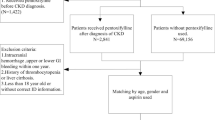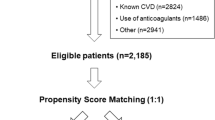Abstract
Haemorrhagic diathesis develops in chronic renal failure, in which calcium antagonists are used widely as antihypertensive agents. Although calcium antagonists are reported to impair platelet function, it has not been examined whether calcium antagonists alter bleeding time. The present study was conducted to clarify whether calcium antagonists affect bleeding time in chronic renal failure. Patients with chronic renal failure without and with calcium antagonists were enrolled (n = 156), and bleeding time (Ivy's method) as well as blood parameters (BUN, creatinine, platelet counts, and haemoglobin) were compared in patients with normal and prolonged bleeding time. Among patients not taking calcium antagonists (n = 34), three cases manifested prolonged bleeding time, whereas abnormal bleeding time was observed in 31 patients out of 122. Positive correlations were observed between bleeding time and BUN in both calcium antagonist-untreated (r = 0.46) and -treated groups (r = 0.25). The odds ratio for prolongation of bleeding time in patients taking calcium antagonists was 3.52 (95% CI, 1.01–12.33). In 12 calcium antagonist-treated patients with prolonged bleeding time, the withdrawal of calcium antagonists markedly shortened bleeding time (from 11.3 ± 0.8 to 5.4 ± 0.8 min, P < 0.05, n = 12). In contrast, in the additional group (n = 9), the continued treatment with calcium antagonists had no effect on bleeding time (from 11.7 ± 0.9 to 10.0 ± 1.0 min). Despite the inhibitory effect of calcium antagonists on bleeding time, no clinically serious events associated with haemorrhagic diathesis developed. In conclusion, calcium antagonists prolong bleeding time in patients with chronic renal failure. The subclinical (laboratory) effect of calcium antagonists however is not necessarily associated with haemorrhagic events of clinical significance.
This is a preview of subscription content, access via your institution
Access options
Subscribe to this journal
Receive 12 digital issues and online access to articles
$119.00 per year
only $9.92 per issue
Buy this article
- Purchase on Springer Link
- Instant access to full article PDF
Prices may be subject to local taxes which are calculated during checkout



Similar content being viewed by others

References
Di Minno G et al. Platelet dysfunction in uremia Am J Med 1985 79: 552–559
Sagripanti A, Barsotti G . Bleeding and thrombosis in chronic uremia Nephron 1997 75: 125–139
Takahara K et al. Effects of nifedipine on platelet function Am Heart J 1985 109: 4–8
Ware JA, Schwartz JB, Horak JK, Solis RT . Inhibition of platelet aggregation by oral dogoxin and reversal with nifedipine J Cardiovasc Pharmacol 1985 7: 262–266
Johnsson H . Effects by nifedipine on platelet function in vitro and in vivo Thrombosis Res 1981 21: 523–528
Dale J, Landmark KH, Myhre E . The effects of nifedipine, a calcium antagonist, on platelet function Am Heart J 1983 105: 103–105
Larsson SO . On coagulation and fibrinolysis in renal failure Scand J Haematol 1971 15: 1–59
Horowitz HI . Uremic toxins and platelet function Arch Intern Med 1970 126: 823
Horowitz HI, Stein IM, Cohen BD, White JG . Further studies on the platelet-inhibitory effect of guanidino-succinic acid and its role in uremic bleeding Am J Med 1970 49: 336
Knight CJM et al. Different effects of calcium antagonists, nitrates, and beta-blockers on platelet function: possible importance for the treatment of unstable angina Circulation 1997 95: 125–132
Zhang X, Hintze TH . Amlodipine releases nitric oxide from canine coronary microvessels: an expected mechanism of action of a calcium channel-blocking agent Circulation 1998 97: 576–580
Berkels R et al. The calcium antagonist nifedipine stimulates endothelial NO release in therapeutic concentrations Pharm Phamacol Lett 1996 6: 75–78
Ding Y, Vaziri ND . Calcium channel blockade enhances nitric oxide synthase expression by cultured endothelial cells Hypertension 1998 32: 718–723
Noris M, Remuzzi G . Uremic bleeding: closing the circle after 30 years of controversies? Blood 1999 94: 2569–2574
Thomas G, Ramwell PW . Identification of guanidino-succinate as a putative endogenous source of the endothelium derived relaxing factor Biochem Biophys Res Commun 1992 183: 584–589
Todeschini M et al. Guanidino succinate stimulates the release of nitric oxide (NO) from cultured endothelial cells: possible implications for uremic bleeding J Am Soc Nephrol 1998 9: 23A
Remuzzi G et al. Role of endothelium-derived nitric oxide in the bleeding tendency of uremia J Clin Invest 1990 86: 1768–1781
Pahor M et al. Risk of gastrointestinal haemorrhage with calcium antagonists in hypertensive persons over 67 years old Lancet 1996 347: 1061–1065
Acknowledgements
This study was supported in part by a Grant-in-Aid for Scientific Research (B)-No. 10671004 from the Ministry of Education, Science, Sports and Culture.
Author information
Authors and Affiliations
Corresponding author
Rights and permissions
About this article
Cite this article
Hayashi, K., Matsuda, H., Honda, M. et al. Impact of calcium antagonists on bleeding time in patients with chronic renal failure. J Hum Hypertens 16, 199–203 (2002). https://doi.org/10.1038/sj.jhh.1001327
Received:
Revised:
Accepted:
Published:
Issue Date:
DOI: https://doi.org/10.1038/sj.jhh.1001327


